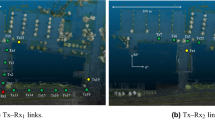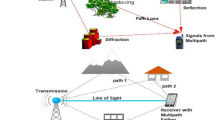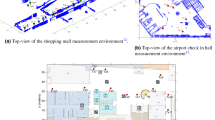Abstract
When the wireless signal propagates between the transmitter (Tx) and the receiver (Rx), it will undergoes many variations as diffraction, scattering or reflecting due to the presence of many obstacles along the propagation area. The objective of channel modeling is to retrieve how the signal can be distorted or attenuated. In this paper, a statistical model was established to characterize indoor Ultra WideBand channel, based on measurements campaign which has been performed within the whyless.com project by the IMST group. The amplitude of narrowband channel was found to be well-fitted by Rayleigh or Rice distribution depending on the obstruction of the line of sight or not. Herein, the adopted approach consists to model separately the shadowing and the deep fading that occur when the Tx–Rx distance varies within large or small area. For the shadow fading a twofold exponential decay was suggested, providing excellent fit to the estimated averaged power delay profile. For the Small scale fading, the proposed model employs the Generalized Gamma distribution \((\text{ G }\varGamma \text{ D })\) as a flexible model including many of well-known distributions as special cases. The process of modeling was presented finally and validated by comparing simulated and experimented channel parameters.










Similar content being viewed by others
References
Chong, C. C., Watanabe, F., & Inamura, H. (Aug. 2006). Potential of UWB technology for the next generation wireless communications. In Proceedings of the 9th IEEE international symposium on spread spectrum techniques and applications (ISSSTA ’06) (pp. 422–429). Amazon, Brazil: Manaus.
Molisch, A. F., Balakrishnan, K., Chong, C.C., Emami, S., Fort, A., Karedal, J., Kunish, J., Schantz, H., Schuster, U., & Siwiak, K. (2004). IEEE 802.15.4a channel model—final report. IEEE 802.15.4A Task, Group.
Hamalainen, M., Pirinen, P., Shelby, Z., & Iinatti, J. (2008). Wireless applications in healthcare and welfare. In Frigyes, I., Bito, J., Bakki, P. (Eds.) Advances in mobile and wireless communications: Views of the 16th IST mobile and wireless communication summit, Lecture Notes in Electrical Engineering, vol. 16.
IEEE 802.11p—Part 11: Wireless LAN medium access control (MAC) and physical layer (PHY) specifications: Amendment 6: Wireless access in vehicular environments, doi:10.1109/IEEESTD (July. 2010).
Michelson, D. G., & Ghassemzadeh S. S. (2009). Measurement and modelling of wireless channels, In Tarokh, V. (Ed.) New directions in wireless communications research. New York: Springer, pp. 1–27, ISBN: 978-1-4419-0672-4.
Di Renzo, M., Graziosi, F., Santucci, F., Minutolo, R., & Montanari, M. (June 2005). The ultra-wide bandwidth outdoor channel: From measurement campaign to statistical modelling. Dresden, Germany: IST Mobile and & Wireless Communications Summit.
Santos, T., Tufvesson, F., & Molisch, A. F. (2010). Modeling the ultra-wideband outdoor channel: Model specification and validation. IEEE Transactions on Wireless Communications, 9(6), 1987–1997.
Ahmadi-Shokouh, J., & Qiu, R. C. (2009). Ultra-wideband (UWB) communications channel measurements—a tutorial review. International Journal of Ultra Wideband Communications and Systems, 1(1), 11–31.
Molisch, A. F., Cassioli, D., Chong, C.-C., Emami, S., Fort, A., Kannan, B., et al. (2006). A comprehensive standardized model for ultrawideband propagation channels. IEEE Transactions on Antennas Propagation, 54(11), 3151–3166.
Hashemi, H. (1993). Impulse response modeling of indoor radio propagation channels. IEEE JSAC, 11(7), 967–978.
Ganesh, R., & Pahlavan, K. (1989). On arrival of paths in fading multipath indoor radio channels. In Proceeding of global telecommunications conference pp. 1346–1350.
Massey, F. J. (1951). The Kolmogorov–Smirnov test for goodness of fit. The Journal of American Statistical Association, 46(253), 68–78.
Fenton, L. (1960). The sum of log-normal probability distributions in scatter transmission systems. IEEE Transactions on Communications Systems, CS–8(1), 57–67.
Cho, Y. S., Kim, J., Yang, W. Y., & Kang, C. G. (2010). MIMO-OFDM Wireless Communications with MATLAB, chapter 1, London: Wiley.
Siwiak, K., Bertoni, H. L., & Yano, S. M. (Jan. 2003). Relation between multipath and wave propagation attenuation. Electronic Letters 9th, 39(1), 142–143.
Cassioli, D., Win, M. Z., & Molisch, A. F. (2002). The ultra-wide bandwidth indoor channel: From statistical model to simulations. IEEE Journal on Selected Areas of Communications, pp. 1247–1257.
Schuster, U. G., & Boelcskei, H. (2007). Ultrawideband channel modeling on the basis of information-theoretic criteria. IEEE Transactions on Wireless Communications, 6, 2464–2475.
Kunisch, J., & Pamp, J. (2002). Measurement results and modeling aspects for the UWB radio channel. In Proceedings IEEE UWBST, pp. 19–23.
Hovinen, V., Hamalainen, M., & Pätsi, T. (2002). Ultra wideband indoor radio channel models: Preliminary results. In Proceedings IEEE UWBST, pp. 75–79.
Foerster, J. R., & Li, Q. (2002). UWB channel modeling contribution from intel. Tech. Rep. P802.15 02/279SG3a, IEEE P802.15 SG3a contribution.
Stacy, E. W. (1962). A generalization of the gamma distribution. The Annals of Mathematical Statistics, 33(3), 1187–1192.
Cohen, A. C., & Whitten, B. J. (1988). Parameter estimation in reliability and life span models. New York: Marcel Dekker.
Johnson, N. L., & Kotz, S. (1970). Continuous univariate distributions. Boston: Houghton-Mifflin.
Jonkman, J. N., Gerard, D. P., & Swallow, H. W. (2009). Estimating probabilities under the three-parameter gamma distribution using composite sampling. Computational Statistics and Data Analysis, 53(4), 1099–1109.
Press, W. H., Flannery, B. P., Teukolsky, S. A., & Vetterling, W. T. (Sep. 1992). Chapter 7–2: Rejection methods, 2 edition. Cambridge: Cambridge University Press, 052143064X.
Author information
Authors and Affiliations
Corresponding author
Rights and permissions
About this article
Cite this article
Mohammadi, Z., Saadane, R. & Aboutajdine, D. On Ultra Wideband Indoor Channel Modeling Based on Generalized Gamma Distribution. Wireless Pers Commun 74, 529–544 (2014). https://doi.org/10.1007/s11277-013-1304-8
Published:
Issue Date:
DOI: https://doi.org/10.1007/s11277-013-1304-8




